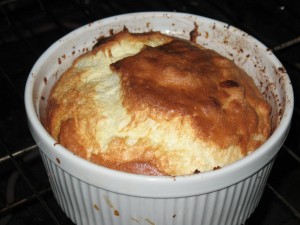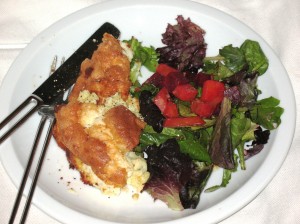Blue cheese soufflé
June 10, 2010
Souffles are (a) vaguely mysterious, (b) apparently quite versatile, and © chemically interesting. So as soon as I saw Ina Garten make this blue cheese souffle, I wanted to try it.
Wikipedia says a soufflé is a “light, fluffy, baked cake made with egg yolks and beaten egg whites combined with various other ingredients and served as a savory main dish or sweetened as a dessert”. Sounds right. (For the curious, Wikipedia goes on to explain that “soufflé” essentially means “something puffed up” in French. Fair, right? Compare English “sufflate”, and indeed “inflate”.)
To make a souffle, you start by making a custard with your featured ingredient, which in this case was blue cheese. So blue cheese, egg yolks, milk, and some spices get mixed together, in a very specific way, with the yolks and cheese going in last. Then, you whip some egg whites into a meringue. Adding cream of tartar helps to stabilize the resulting foam (I will explain exactly how in a future post).
The meringue is folded into the custard. When the entire mixture goes into the oven, the ingredients are cooked, the foam hardens a bit, and the air trapped in the egg white foam increases dramatically in volume, resulting in a dish with a deliciously airy consistency.
For some reason, souffles have a reputation for being extremely temperamental (a common joke in cartoons is the souffle that falls in the oven at the slightest noise, a stereotype I certainly had in mind when I first thought of making one). But it just isn’t so. The souffle will settle a bit after a few minutes out of the oven, but by that time you’ve cut it up and put it on plates.
I served this souffle with a simple salad with red peppers. “Light” is probably not the right word for a meal whose main component is whole eggs, blue cheese, and milk, but it almost felt that way.
Update: Here are some rules for souffles that I picked up from this wonderful book by Herve This, p.183.
“Be sure to beat the egg whites until they are very stiff, so that on the one hand the steam formed at the bottom of the ramekin during cooking cannot easily escape, and on the other, the steam pushes the souffle upwards rather than sideways.”
“Before cooking, quickly put the ramekin under the broiler in order to get a very smooth, slightly golden surface that will retain the steam formed during cooking and assure a more uniform expansion.”
“The souffle is cooked by heating the ramekin from the bottom. You may wish first to place the ramekin over a flame to make the souffle rise before putting it in the oven.”

